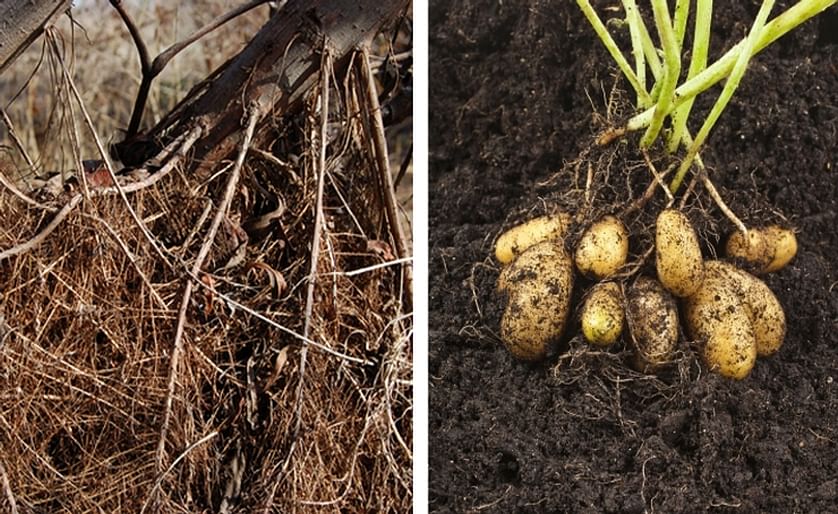Scientists at Cornell University have developed an electric capacitance measurement that is able to predict the root mass of willow shrubs and trees (left). However, they hint it may helpful for tubers (right) and root crops as well.
Method developed to predict root mass of willow shrubs may be helpful for potato crop as well

Scientists at Cornell University have developed an electric capacitance measurement that is able to predict the root mass of shrubs and trees.
What's more, they hint it may helpful for tubers and root crops as well.
An understanding of root morphology is of tremendous importance for agricultural and biofuel crops alike.
The measurement of the belowground traits of plants has become increasingly important because of the vital role that root biomass and architecture play in traits like drought tolerance and carbon sequestration.
The ability to measure root biomass is useful in plant breeding programs, but is a daunting task that requires washing, filtering, drying, and weighing fine and intricate root tissues.
Researchers have used electrical capacitance—the ability of an object to store an electrical charge—to measure root biomass, but this technique had only been shown to work in hydroponically grown plants and had not been extensively tested in soil-grown woody plants grown from cuttings.
As Craig Carlson, a PhD candidate at Cornell University's College of Agriculture and Life Sciences:
Despite being initially skeptical that the root electrical capacitance (REC) method would work in soil, Carlson was able to tweak the technique and demonstrate its efficacy in a paper published in a recent issue of Applications in Plant Sciences. Using a relatively simple setup composed of a stem clamp, soil probe, and capacitance meter, this new application of the REC method allows for quick predictions of dry root biomass across a variety of shrub willow species and species hybrids and circumvents the need to meticulously sift through soil to tease apart fine roots for measurements.
Shrub willows are excellent species for growth as a low-input renewable biofuels crop. Individuals are planted from cuttings, and then cut down to the stump, allowing regrowth of numerous new stems from the original rootstock, known as coppicing. Every three years the aboveground biomass can be harvested and used as woodchips in large-scale power plants and as pellets for heating homes and other fuel applications. This three-year-growth and coppice cycle can be repeated for over 20 years per individual. While other tree and shrub species exhibit coppicing growth habits, shrub willows are an ideal biofuels crop because of their quick growth, low need for inputs, and quick deposition of carbon. An understanding of root biomass provides an ideal indicator of a plant's potential future growth and helps in optimizing selection of cultivars in breeding to hone in on those more capable of coping with drought and marginal growing conditions.
The breeding program led by Smart has made tremendous strides in breeding new hybrids that grow quickly, provide increased biomass yields, are resistant to pests and disease, and demonstrate an increasing capacity to grow in less-than-ideal environments, thereby reducing competition with food crops.
Larry Smart:
Larry Smart:
The REC method has already gained traction and was implemented with undergraduate research during the summer of 2016. The students looked at drought stress and hybrid vigor in both above- and belowground traits.
While this new application of the REC method is an excellent addition to their toolbox, Smart and Carlson hope that their technique will be implemented in other areas of research, including assessments of environmental responses, adaptations to growing conditions, and agriculture.
Craig Carlson:
Larry Smart:
What's more, they hint it may helpful for tubers and root crops as well.
An understanding of root morphology is of tremendous importance for agricultural and biofuel crops alike.
The measurement of the belowground traits of plants has become increasingly important because of the vital role that root biomass and architecture play in traits like drought tolerance and carbon sequestration.
The ability to measure root biomass is useful in plant breeding programs, but is a daunting task that requires washing, filtering, drying, and weighing fine and intricate root tissues.
Researchers have used electrical capacitance—the ability of an object to store an electrical charge—to measure root biomass, but this technique had only been shown to work in hydroponically grown plants and had not been extensively tested in soil-grown woody plants grown from cuttings.
As Craig Carlson, a PhD candidate at Cornell University's College of Agriculture and Life Sciences:
"A majority of electroconductivity studies have focused on annual grasses and hydroponic systems."Carlson works with Dr. Larry Smart, leader of North America's largest breeding program for shrub willow (Salix spp.), an important biofuel crop. One aspect of their breeding work requires growing up to 400 individual plants in separate pots, and an efficient method to quantify root biomass would allow for rapid selection of individuals with optimal traits to continue breeding. The alternative is to mechanically remove soil to measure root biomass, a method that is both destructive and extremely time consuming.
"We wanted to develop a cheap, quick method of measuring root biomass in soils."
Despite being initially skeptical that the root electrical capacitance (REC) method would work in soil, Carlson was able to tweak the technique and demonstrate its efficacy in a paper published in a recent issue of Applications in Plant Sciences. Using a relatively simple setup composed of a stem clamp, soil probe, and capacitance meter, this new application of the REC method allows for quick predictions of dry root biomass across a variety of shrub willow species and species hybrids and circumvents the need to meticulously sift through soil to tease apart fine roots for measurements.
Publication:
Craig H. Carlson et al, Electrical Capacitance as a Predictor of Root Dry Weight in Shrub Willow (; Salicaceae) Parents and Progeny, Applications in Plant Sciences (2016). DOI: 10.3732/apps.1600031The breeding program led by Smart has made tremendous strides in breeding new hybrids that grow quickly, provide increased biomass yields, are resistant to pests and disease, and demonstrate an increasing capacity to grow in less-than-ideal environments, thereby reducing competition with food crops.
Larry Smart:
"Craig's method allows us to select new cultivars that could be more drought tolerant or be able to occupy marginal sites, such as reclaimed mine sites in West Virginia,"A key to any successful plant breeding program is incorporating a variety of different species and their hybrid offspring.
Larry Smart:
"Interspecific [between species] hybrids are important because we see hybrid vigor."The REC method marks a significant step forward in the shrub willow breeding program. While Smart's group was previously limited to selecting hybrids according to aboveground traits, Carlson's method allows them to explore subterranean variation as well.
The REC method has already gained traction and was implemented with undergraduate research during the summer of 2016. The students looked at drought stress and hybrid vigor in both above- and belowground traits.
While this new application of the REC method is an excellent addition to their toolbox, Smart and Carlson hope that their technique will be implemented in other areas of research, including assessments of environmental responses, adaptations to growing conditions, and agriculture.
Craig Carlson:
"This method could be directly applied to breeding programs for crops that generally require grafting to rootstocks to maintain scion varieties (apples, for example)."Additionally, it will be helpful for other agricultural species "including tubers or other root crops," adds Carlson.
Larry Smart:
"Our next step is to take this method into the field and see if these correlations hold up."
Source
Phys.org / Botanical Society of America




